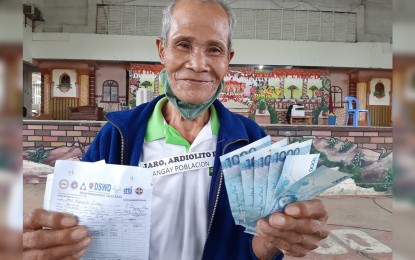
(Photo courtesy of DSWD)
MANILA – The Department of Social Welfare and Development (DSWD) is currently updating its Listahanan or the master list of poor Filipino households that will serve as the agency’s basis of identification and selection of potential beneficiaries for various poverty alleviation and social protection programs.
For the distribution of aid to address the ongoing public health crisis, recipients of DSWD’s financial assistance programs included households enlisted under the Listahanan 2 completed in 2016.
Under the DSWD's guidelines, poor households identified by the national household targeting system for poverty reduction (NHTS-PR) or known as Listahanan, primarily 4Ps beneficiaries, shall be prioritized for the Emergency Cash Assistance (ECA).
In cases where there are households not included in the 4Ps operation or in the Listahanan 1 and 2, the guidelines allow for their inclusion, particularly families residing in easily isolated or in geographically isolated disaster areas, and families with persons with disabilities, elderly, children, and pregnant or lactating women.
Though there were several cash assistance programs from different government offices, DSWD received the ire of the public over concerns on their database.
Revalidation
On Monday’s Network News Briefing via the Presidential Communications Operations Office (PCOO), Imelda, Zamboanga Sibugay Mayor Roselyn Silva forwarded a concern on how to revalidate the beneficiaries of the DSWD’s Pantawid Pamilyang Pilipino Program (4P’s).
“When I was seated in 2013, in one of the distributions to 4P’s beneficiaries, I observed that some of them do not look/seem like a [qualified] beneficiary to me. What can we do to reassess the list?” she asked.
In the same briefer, DSWD spokesperson Irene Dumlao said the public has ways to contest the list.
“We have what we call municipal links. Through them, our field officers, the person can submit a report regarding his concern,” she said.
Dumlao further explained that the agency’s social welfare assistants or grievance officers will then process the case of inclusion or exclusion.
A case assessment or case conference will follow through to validate whether the person is qualified to receive the benefits offered by the agency.
Nationwide assessment
In compliance with Section 2 of Executive Order 867 which requires the DSWD to update the NHTS-PR every four years, the agency's National Household Targeting Office (NHTO) embarked on its third nationwide assessment in October 2019.
However, it was put on hold due to the announcement of quarantine restrictions in the NCR and other regions in mid-March 2020 to contain the spread of the coronavirus disease 2019 (Covid-19).
NHTO director, lawyer Justin Batocabe, said during an interview that they are on the third phase of the NHTS-PR which is the validation and finalization.
Next comes the reports generation phase.
As per the National Privacy Commission (NPC) Privacy Policy Office advisory opinion No. 2020-023, it said in a statement that they “understand further that the DSWD will be posting an initial list of the poor households at the barangay office and other designated public places."
It was also stated that the purpose of this phase is to enable the households to review and validate the information and at the same time, provide the opportunity for the community, especially those who were not assessed during the data collection phase, to file grievances for non-inclusion in the list, and appeals and complaints on possible errors such as family information, classification, and non-assessment.
All grievances shall then be evaluated by the Barangay Verification Committee and Local Verification Committee at the municipal level, it added.
Notably though, that prior to the lockdown, the NHTO had finished surveying around 12 million out of the targeted 16.1 million households nationwide.
Of the 12 million households surveyed, data collected for 8.3 million poor households have undergone verification and are considered “official”, the Asian Development Bank (ADB), one of the agency's sponsors said through a public document.
Meanwhile, the data for 6.5 million households (78 percent of 8.3 million) have been encoded.
For the NCR alone, NHTO had planned to survey 600,000 households in all.
As of March 14, some 400,000 households, or 66 percent, have already been surveyed and assessed.
The information on 85,000 households has been encoded, the ADB added.
The NHTO has recently resumed its operations and according to Batocabe, the initial list will be released in November 2020 for public appeal.
The agency is eyeing to finish the database of poor families under Listahanan 3 in February 2021.
Listahanan or the NHTS-PR, is an information management system that employs geographic targeting, household assessment, and validation in order to provide national government agencies, development partners, and other social protection actors with information on who and where the poor are in the Philippines.
This information is then used for the identification and selection of potential beneficiaries for various poverty alleviation and social protection programs. (PNA)
